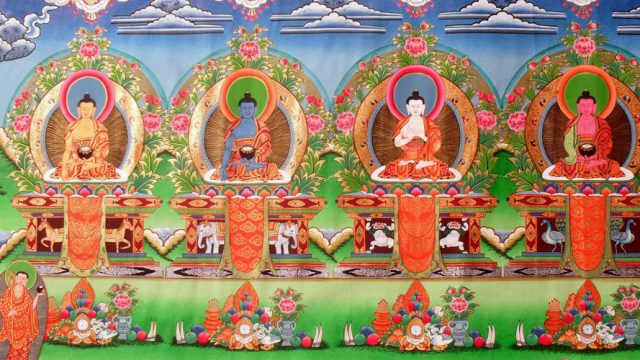If you’re travelling almost anywhere in the Himalaya, be it a weekend getaway like McLeodganj, or on a trek to the Everest Base Camp in Nepal, you are bound to come across many Tibetan Buddhist monasteries and be dazzled by the extraordinary images of Buddhist deities. To those who aren’t well-versed with Mahayana Buddhism and it’s tantric form, Vajrayana, the deities might seem confusing. To help you out, we’ve compiled a basic go-to guide of the main gods, goddesses and Buddhas that you might encounter.
While all these deities have their roots in India, today, most of them are either forgotten here or have been absorbed into Hinduism. So, for example, you might be amazed to know that the beloved goddess Tara is actually a Bodhisattva (and even, to some, a Buddha), and that her identity as a form of the Hindu Kali or Durga happened much later. So read on, and the next time you’re at a monastery, you won’t be so confused.
The Bodhisattvas

All over the Buddhist landscape you will find shrines dedicated to the three main Bodhisattvas: Manjushri, Avalokiteshvara and Vajrapani, who deal with the three evils: Delusion, Passion and Wrath. Manjushri is the Bodhisattva of Wisdom, white in colour, wielding a flaming sword, which cuts down the curtains of delusion. Avalokiteshvara is the Bodhisattva of Compassion. He is usually depicted as being red in colour, holding a lotus. The Dalai Lama is said to be the embodiment of Avalokiteshvara. Vajrapani, holder of the diamond thunderbolt, is the embodiment of spiritual energy and power. He is blue or black in colour, wearing a tiger skin and human skulls as ornament, surrounded by an aureole of flames.
The Five Buddhas or the Pancha Tathagatas

In many wall paintings of the monasteries of Tibetan Buddhism, apart from the historical Buddha, Shakyamuni, you will find images of sets of five Buddhas. They signify a cosmic pattern of the universality of Buddhahood. The five Buddhas are simply Buddha Vairochana or the illuminator in the centre surrounded by Buddha Akshobhya, the Unshakeable, radiant blue in colour; Buddha Ratnasambhav, Jewel-born, yellow in colour, who transforms pride into the wisdom of equanimity; Buddha Amitabha, Infinite Light, red in colour, the Buddha of love and compassion; and Buddha Amoghasiddhi, green in colour, associated with fearlessness. The Pancha Tathagata form the basis of the ordering of all Buddhist deities according to tantric system. All other deities, Bodhisattvas, wrathful gods etc, fall under one or the other of 5 families or kula, headed by one of the 5 Buddhas.
Prajnaparamita, the Mother of the Buddhas

Prajnaparamita is a goddess, but she is also a book. The Perfection of Wisdom, is a foundational sutra for the Mahayana, and the goddess embodies the essence of this divine knowledge, that which powers the enlightenment and power of all the Buddhas. Like all Mahayana deities, she is venerated in a cult of the book, as can be seen from her iconography, where she’s often seen holding a palm-leaf manuscript of the sutra.
Tara

The most beloved of all Buddhist deities, Tara comes in many guises and colours, each signifying an aspect of her power. She is said to have been born from the tears of Avalokiteshvara as he contemplated the sufferings of the universe, Tara is called the ‘Quintessence of Compassion’ and also delivers her worshippers from the all troubles. Although she has many avatars, including fierce, tantric ones, her most common depiction is in the form of the Green Tara (Shyama Tara) who protects the devotee from physical and spiritual danger, or White Tara (Sheeta Tara) associated with longevity, merit and wisdom.
This list only scratches the surface, however. If you’re interested in knowing more, check out Benoytosh Bhattacharyya’s seminal book The Indian Buddhist Iconography. If you’d like to know more about Buddhist goddesses, check out Miranda Shaw’s book Buddhist Goddesses of India.




